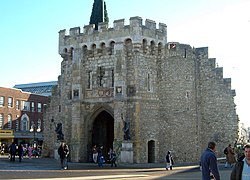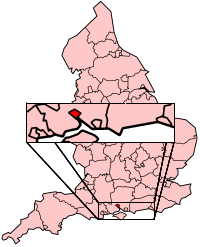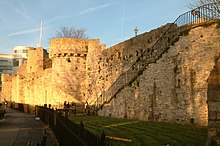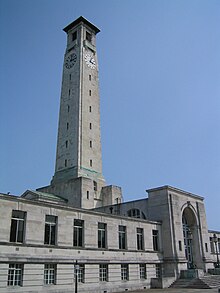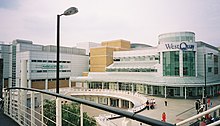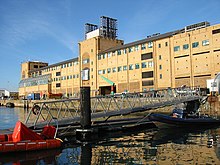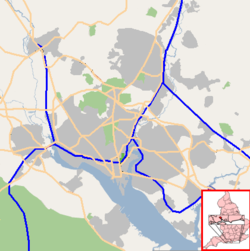Southampton
| Southampton | |||
|---|---|---|---|
| — Unitary & City — | |||
| The Bargate, Southampton | |||
|
|||
| Southampton shown within England | |||
| Sovereign state | United Kingdom | ||
| Constituent country | England | ||
| Region | South East England | ||
| Ceremonial county | Hampshire | ||
| Admin HQ | Southampton | ||
| Settled | c. AD43 | ||
| City Status | 1964 | ||
| Unitary Authority | 1997 | ||
| Government | |||
| - Type | Unitary authority, City | ||
| - Governing body | Southampton City Council | ||
| - Leadership | Leader & Cabinet | ||
| - Executive | Conservative | ||
| - MPs |
John Denham (L) Alan Whitehead (L) Caroline Nokes (C) |
||
| Area | |||
| - Unitary & City | 19.9 sq mi (51.47 km2) | ||
| Population (2007 est) | |||
| - Unitary & City | 234,100(Ranked 57) | ||
| - Density | 11,535.8/sq mi (4,454/km2) | ||
| - Urban | 304,400 (Southampton Urban Area) | ||
| - Metro | 1,000,000 | ||
| - County | 1,691,001 (Hampshire) | ||
|
- Ethnicity (United Kingdom 2005 Estimate) [1] |
89.4% White 4.6% S. Asian 1.8% Black. 2.5% Chinese or other 1.8% Mixed Race |
||
| Time zone | Greenwich Mean Time (UTC+0) | ||
| - Summer (DST) | British Summer Time (UTC+1) | ||
| Postcode span | SO14-SO19 | ||
| Area code(s) | 023 | ||
| Grid Ref. | SU 42 11 | ||
| ONS code | 00MS | ||
| Website | www.southampton.gov.uk/ | ||
Southampton (pronounced /saʊθˈhæmptən/ (![]() listen)) is the largest city in the county of Hampshire on the south coast of England,[2] and is situated 100 km (62 mi) south-west of London and
30 km (19 mi) north-west of Portsmouth. Southampton is a major port and the closest city to the New Forest. It lies at the northernmost point of
Southampton Water at the confluence of the River Test and River Itchen,[3] with the River Hamble joining to the south of the urban area. The local authority is Southampton City Council, which is a unitary
authority.
listen)) is the largest city in the county of Hampshire on the south coast of England,[2] and is situated 100 km (62 mi) south-west of London and
30 km (19 mi) north-west of Portsmouth. Southampton is a major port and the closest city to the New Forest. It lies at the northernmost point of
Southampton Water at the confluence of the River Test and River Itchen,[3] with the River Hamble joining to the south of the urban area. The local authority is Southampton City Council, which is a unitary
authority.
Significant employers in Southampton include the University of Southampton, the Ford Transit factory, Ordnance Survey, the BBC through Radio Solent and South Today, the NHS and one of the largest commercial ports in Europe.[citation needed] The city represents the core of the Greater Southampton region, and the city itself has an estimated population of 234,600 (MYE 2008).[4] The city's name is sometimes abbreviated in writing to "So'ton" or "Soton", and a resident of Southampton is called a Sotonian.[5] Southampton is noted for its association with the RMS Titanic,[6] the Spitfire[7] and more recently a number of the largest cruise ships in the world.[8][9]
Contents[hide] |
[edit] History
Archaeological finds suggest that the area has been inhabited since the stone age.[10] According to the Chronicle of the Britons the Ancient Britons had called the place Porth Hamon after a certain Lelius Hamo, a traitor who had murdered king Togodumnus during the early stages of the Roman invasion of Britain.[11] Following the Roman invasion of Britain in AD 43 and the conquering of the local Britons in 70 AD the fortress settlement of Clausentum was established. It was an important trading port and defensive outpost of Winchester, at the site of modern Bitterne Manor. Clausentum was defended by a wall and two ditches and is thought to have contained a bath house.[12] Clausentum was not abandoned until around 410.[10]
The Anglo-Saxons formed a new, larger, settlement across the Itchen centred on what is now the St Mary's area of the city. The settlement was known as Hamwic,[10] which evolved into Hamtun and then Hampton.[13] Archaeological excavations of this site have uncovered one of the best collections of Saxon artifacts in Europe.[10] It is from this town that the county of Hampshire gets its name.
Viking raids from 840 onwards contributed to the decline of Hamwic in the 9th century,[14] and by the 10th century a fortified settlement, which became medieval Southampton had been established.[15]
Following the Norman Conquest in 1066, Southampton became the major port of transit between the then capital of England, Winchester, and Normandy. Southampton Castle was built in the 12th century[16] and by the 13th century Southampton had become a leading port, particularly involved in the import of French wine[15] in exchange for English cloth and wool.[17]
Surviving remains of 12th century merchants' houses such as King John's House and Canute's Palace are evidence of the wealth that existed in the town at this time.[18] In 1348, the Black Death reached England via merchant vessels calling at Southampton.[19]
The town was sacked in 1338 by French, Genoese and Monegasque ships (under Charles Grimaldi, who used the plunder to help found the principality of Monaco).[20] On visiting Southampton in 1339, Edward III ordered that walls be built to 'close the town'. The extensive rebuilding—part of the walls dates from 1175—culminated in the completion of the western walls in 1380.[21][22] Roughly half of the walls, 13 of the original towers, and six gates survive.[21]
The city walls include God's House Tower, built in 1417, the first purpose-built artillery fortification in England.[23] Over the years it has been used as home to the city's gunner, the Town Gaol and even as storage for the Southampton Harbour Board.[22] Today, it is open as the Museum of Archaeology. The walls were completed in the 15th century,[24] but later development of several new fortifications along Southampton Water and the Solent by Henry VIII meant that Southampton was no longer dependent upon its fortifications.[25]
On the other hand, many of the medieval buildings once situated within the town walls are now in ruins or have disappeared altogether. From successive incarnations of the motte and bailey castle, only a section of the bailey wall remains today, lying just off Castle Way.[26] The last remains of the Franciscan friary in Southampton, founded circa 1233 and dissolved in 1538, were swept away in the 1940s.[27] The site is now occupied by Friary House.
Elsewhere, remnants of the medieval water supply system devised by the friars can still be seen today. Constructed in 1290, the system carried water from Conduit Head (remnants of which survive near Hill Lane, Shirley) some 1.7 kilometres to the site of the friary inside the town walls. The friars granted use of the water to the town in 1310 and passed on ownership of the water supply system itself in 1420.[28] Further remains can be observed at Conduit House on Commercial Road.
In 1642, during the English Civil War, a Parliamentary garrison moved into Southampton.[29] The Royalists advanced as far as Redbridge in March 1644 but were prevented from taking the town.[29]
During the Middle Ages, shipbuilding became an important industry for the town. Henry V's famous warship HMS Grace Dieu was built in Southampton.[16] Walter Taylor's 18th century mechanisation of the block-making process was a significant step in the Industrial Revolution.[30] From 1904 to 2004, the Thornycroft shipbuilding yard was a major employer in Southampton,[16] building and repairing ships used in the two World Wars.[16]
Prior to King Henry's departure for the Battle of Agincourt in 1415, the ringleaders of the "Southampton Plot"—Richard, Earl of Cambridge, Henry Scrope, 3rd Baron Scrope of Masham and Sir Thomas Grey of Heton—were accused of high treason and tried at what is now the Red Lion public house in the High Street.[31] They were found guilty and summarily executed outside the Bargate.[32]
Southampton has been used for military embarkation, including during 18th century wars with the French,[33] the Crimean war,[34] and the Boer War.[35] Southampton was designated No. 1 Military Embarkation port during the Great War[16] and became a major centre for treating the returning wounded and POWs.[16] It was also central to the preparations for the Invasion of Europe in 1944.[16]
Southampton became a spa town in 1740.[36] It had also become a popular site for sea bathing by the 1760s, despite the lack of a good quality beach.[36] Innovative buildings specifically for this purpose were built at West Quay, with baths that were filled and emptied by the flow of the tide.[36]
The town experienced major expansion during the Victorian era.[16] The Southampton Docks company had been formed in 1835.[16] In October 1838 the foundation stone of the docks was laid[16] and the first dock opened in 1842.[16] The structural and economic development of docks continued for the next few decades.[16] The railway link to London was fully opened in May 1840.[16] Southampton subsequently became known as The Gateway to the Empire.[37]

The port was the point of departure for the Pilgrim Fathers aboard the Mayflower in 1620.[21] In 1912, the RMS Titanic sailed from Southampton. Four in five of the crew on board the vessel were Sotonians,[38] with about a third of those who perished in the tragedy hailing from the city.[21] Southampton was subsequently the home port for the transatlantic passenger services operated by Cunard with their Blue Riband liner RMS Queen Mary and her running mate RMS Queen Elizabeth. In 1938, Southampton docks also became home to the flying boats of Imperial Airways.[16] Southampton Container Terminals first opened in 1968[16] and has continued to expand.
The Supermarine Spitfire was designed and developed in Southampton, evolving from the Schneider trophy-winning seaplanes of the 1920s and 1930s. Its designer, R J Mitchell, lived in the Portswood area of Southampton, and his house is today marked with a blue plaque.[39] Heavy bombing of the factory in September 1940 destroyed it as well as homes in the vicinity, killing civilians and workers. World War II hit Southampton particularly hard because of its strategic importance as a major commercial port and industrial area. Prior to the Invasion of Europe, components for Mulberry Harbour were built here.[16] After D-Day, Southampton docks handled military cargo to help keep the Allied forces supplied,[16] making it a key target of Luftwaffe bombing raids until late 1944.[40]
630 people lost their lives as a result of the air raids on Southampton and nearly 2,000 more were injured, not to mention the thousands of buildings damaged or destroyed.[2]

Pockets of Georgian architecture survived the war, but much of the city was levelled. There has been extensive redevelopment since World War II.[16] Increasing traffic congestion in the 1920s led to partial demolition of medieval walls around the Bargate in 1932 and 1938.[16] However a large portion of those walls remain.
A Royal Charter in 1952[16] upgraded University College at Highfield to the University of Southampton.[16] Southampton acquired city status, becoming the City of Southampton in 1964.[16]
[edit] Government
Southampton used to be a County borough within the county of Hampshire, which in the past was known as the County of Southampton[41] or Southamptonshire.[42] This was officially changed to Hampshire in 1959 although the county had been commonly known as Hampshire or Hantscire for centuries. Southampton became a non-metropolitan district in 1974. However, the city became administratively independent from that county as it was made into a unitary authority in a local government reorganisation on 1 April 1997—a result of the 1992 Local Government Act. The district remains part of the Hampshire ceremonial county.
Southampton City Council consists of 48 councillors, 3 for each of sixteen wards. Elections are held in early May for one third of the seats (one councillor for each ward), elected for a four year term, so there are elections 3 years out of 4. As of 2010 the composition of the council is:
| Party | Members | |
|---|---|---|
|
|
Conservative | 28 |
|
|
Labour | 15 |
|
|
Liberal Democrats | 5 |
| Total | 48 | |
There are three members of parliament for the city: Rt. Hon. John Denham (Labour) for Southampton Itchen, the constituency covering the east of the city; Dr. Alan Whitehead (Labour) for Southampton Test, which covers the west of the city; and Caroline Nokes (Conservative) for Romsey and Southampton North, which includes a northern portion of the city.
Southampton's police service is provided by Hampshire Constabulary and its fire service by Hampshire Fire and Rescue Service and the ambulance service by the South Central Ambulance Service. Police stations within the city boundaries are at Portswood, Bannister Park, Bitterne, and Shirley, and at the Civic Centre in the city centre. However, a new police head quarters is being built off West Quay Road, near the south side of the railway station. The police will leave the civic centre for this new building when complete. British Transport Police has a police station at Southampton Central railway station. Fire stations are located in St Mary's, Sholing and Redbridge.
[edit] Geography and climate
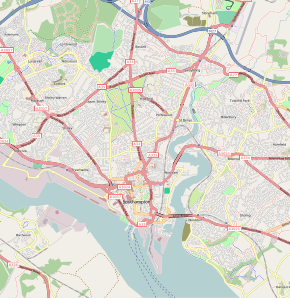
The geography of Southampton is influenced by the sea and rivers. The city lies at the northern tip of the Southampton Water, a deep water estuary, which is a ria formed at the end of the last Ice Age. Here, the rivers Test and Itchen converge.[43] The Test—which has salt marsh that makes it ideal for salmon fishing[44]—runs along the western edge of the city, while the Itchen splits Southampton in two—east and west. The city centre is located on the peninsula between the two rivers.
Much of the waterfront has been reclaimed over the years, mainly for use as the Western Docks.[45] Most of the land used for reclamation came from dredging of Southampton Water,[46] to ensure that the port can continue to handle large ships.
Southampton Water has the benefit of a double high tide, with two high tide peaks,[47] making the movement of large ships easier.[48] This is not caused as popularly supposed by the presence of the Isle of Wight.[49]
The city lies in the Hampshire Basin, which sits atop chalk beds.[43]
The River Test runs along the western border of the city, separating it from the New Forest. There are bridges over the Test from Southampton, including the road and rail bridges at Redbridge in the south and the M27 motorway to the north. The River Itchen runs through the middle of the city and is bridged in several places. The northernmost bridge, and the first to be built,[50] is at Mansbridge, where the A27 road crosses the Itchen. The original bridge is closed to road traffic, but is still standing and open to pedestrians and cyclists. The river is bridged again at Swaythling, where Woodmill Bridge separates the tidal and non tidal sections of the river. Further south is Cobden Bridge which is notable as it was opened as a free bridge (it was originally named the Cobden Free Bridge), and was never a toll bridge. Downstream of the Cobden Bridge is the Northam Railway Bridge, then the Northam Road Bridge, which was the first major pre-stressed concrete bridge to be constructed in the United Kingdom.[51] The southernmost bridge on the Itchen is the Itchen Bridge, which is a toll bridge.
As with the rest of the UK, Southampton experiences an oceanic climate (Köppen Cfb).
| [hide]Climate data for Southampton, England, UK | |||||||||||||
|---|---|---|---|---|---|---|---|---|---|---|---|---|---|
| Month | Jan | Feb | Mar | Apr | May | Jun | Jul | Aug | Sep | Oct | Nov | Dec | Year |
| Average high °C (°F) |
7.8 (46) |
7.8 (46) |
10 (50) |
11.7 (53) |
16.1 (61) |
18.9 (66) |
20.6 (69) |
20.6 (69) |
18.3 (65) |
15 (59) |
10.6 (51) |
8.9 (48) |
13.84 (56.9) |
| Average low °C (°F) |
2.8 (37) |
2.2 (36) |
3.9 (39) |
5 (41) |
7.8 (46) |
11.1 (52) |
12.2 (54) |
12.8 (55) |
11.1 (52) |
7.8 (46) |
5 (41) |
3.9 (39) |
7.13 (44.8) |
| Precipitation mm (inches) |
88.9 (3.50) |
61 (2.40) |
66 (2.60) |
48.3 (1.90) |
55.9 (2.20) |
53.3 (2.10) |
40.6 (1.60) |
55.9 (2.20) |
66 (2.60) |
78.7 (3.10) |
83.8 (3.30) |
88.9 (3.50) |
787.4 (31) |
| Source: Weather.com[52] | |||||||||||||
[edit] Demographics
Southampton has a range of cultures and ethnic groups, which make up the estimated 228,600 people living within the city boundary. There is a large Polish population in the city, with estimates as high as 20,000, or 1 in every 11 of the total population.[53] Southampton also has large Asian and Irish communities. At the 2001 Census, 92.4 per cent of the city's populace were white—including one per cent white Irish—3.8 per cent were South Asian, 1.0 per cent Black, 1.3 per cent Chinese or other ethnic groups, and 1.5 per cent were of mixed race.[54]
There are 112,400 males within the city and 109,500 females.[55] The 20–24 age range is the most populous, with an estimated 28,100 people falling in this age range. Next largest is the 25–29 range with 20,500 people and then 30–34 years with 17,000.[55] By population, Southampton is the largest monocentric city in the South East England region and the second largest on the South Coast after Plymouth.
Between 1996 and 2004, the population of the city increased by 4.9 per cent—the tenth biggest increase in England.[56] In 2005 the Government Statistics stated that Southampton was the third most densely populated city in the country after London and Portsmouth respectively.[57] Hampshire County Council expects the city's population to grow by around a further two per cent between 2006 and 2013, adding around another 4,200 to the total number of residents.[58] The highest increases are expected among the elderly.[58]
[edit] Economy

There are 120,305 jobs in Southampton, and 3,570 people claiming job seeker's allowance, approximately 2.4 per cent of the city's population, as at March 2007.[59] This compares with an average of 2.5 per cent for England as a whole.
As of June 2006, 74.7 per cent of the city's population are classed as economically active.[59]
Just over a quarter of the jobs available in the city are in the health and education sector. A further 19 per cent are property and other business and the third largest sector is wholesale and retail, which accounts for 16.2 percent.[59] Between 1995 and 2004, the number of jobs in Southampton has increased by 18.5 per cent.[56]
As of January 2007, the average annual salary in the city was £22,267. This was £1,700 lower than the national average and £3,800 less than the average for the South East.[60]
Southampton has always been a maritime centre, and the docks have long been a major employer in the city. In particular, it is a port for cruise ships; its heyday was the first half of the 20th century, and in particular the inter-war years, when it handled almost half the passenger traffic of the UK. Today it remains home to luxury cruise ships, as well as being the largest freight port on the Channel coast and fourth largest UK port by tonnage,[61] with several container terminals. Unlike some other ports, such as Liverpool, London, and Bristol, where industry and docks have largely moved out of the city centres leaving room for redevelopment, Southampton retains much of its inner-city industry. Part of the docks has been redeveloped and the Ocean Village development—a local marina and entertainment complex—built. Southampton is home to the headquarters of both the Maritime and Coastguard Agency and the Marine Accident Investigation Branch of the Department for Transport.
During the latter half of the 20th century, a more diverse range of industry also came to the city, including aircraft and car manufacture, cables, electrical engineering products, and petrochemicals. These now exist alongside the city's older industries of the docks, grain milling, and tobacco processing.[3]
Southampton University Hospitals NHS Trust is one of the city's largest employers. It provides local hospital services to 500,000 people in the Southampton area and specialist regional services to more than 3 million people across the South of England. The Trust owns and manages Southampton General Hospital, the Princess Anne Hospital and a palliative care service at Countess Mountbatten House.
Other major employers in the city include Ordnance Survey, the UK's national mapping agency, whose headquarters is in the city. The Lloyd's Register Group has announced plans to move its London marine operations to a specially developed site at the University of Southampton.[62] The area of Swaythling is home to Ford's Southampton Assembly Plant, where the majority of their Transit models are manufactured.
Southampton's largest retail centre is the WestQuay Shopping Centre. Opened in September 2000 and hosting major high street stores, it is one of the largest in the country. The centre was Phase Two of the West Quay development, the first phase of which was the West Quay Retail Park, while the third phase may begin in 2010, now to be called Watermark Westquay. The plans includes shops, housing, an hotel and a public piazza with a planned opening date of 2012.[63] Southampton has been granted a licence for a large casino.[64]
Swedish home products retailer IKEA opened a store on 12 February 2009.[65] near West Quay. Other major shopping areas in the city centre include The Mall Marlands, the Bargate Centre and the East Street area, which has been designated for speciality shopping, with the aim of promoting smaller retailers. In 2007, Southampton was ranked 13th for shopping in the UK.[66]

Southampton's strong economy is promoting redevelopment, and major projects are proposed, including the city's first skyscrapers on the waterfront. The three towers proposed will stand 23 storeys high and will be surrounded by smaller apartment blocks, office blocks and shops. There are also plans for a 15-storey hotel at the Ocean Village marina,[67] and a 21-storey hotel on the north eastern corner of the city centre, as part of a £100m development.[68]
Southampton is the only city in the UK with a geothermal power station. The station provides hot water to a city centre district heating scheme. In a recent survey of carbon emissions in major UK cities conducted by British Gas, Southampton was ranked as being one of the lowest carbon emitting cities in the United Kingdom.[69]
According to 2004 figures, Southampton contributes around £4.2bn to the regional economy annually. The vast majority of this is from the service sector, with the remainder coming from industry in the city. This figure has almost doubled since 1995.[70]
[edit] Culture, media and sport
[edit] Culture
The city is home to the longest surviving stretch of medieval walls in England,[71] as well as a number of museums such as Tudor House Museum, which is currently undergoing extensive restoration and improvement, Southampton Maritime Museum[72] , God's House Tower, an archaeology museum about the citys heritage and located in one of the tower walls, the Medieval Merchant's House and Solent Sky, which focuses on aviation.[73] A Titanic Memorial Museum is planned. Having received half a million pounds from the National Lottery and interest from numerous private investors, the £28 million project is anticipated to open in 2012 — the 100th anniversary year of the tragic maiden voyage. The museum is planned to be inside the western wing of the civic centre, where the old magistrates courts and the police station are currently located
The annual Southampton Boat Show is held in September each year, with over 600 exhibitors present.[74] It runs for just over a week at Mayflower Park on the city's waterfront, where it has been held since 1968.[75] The Boat Show itself is the climax of Sea City, which runs from April to September each year to celebrate Southampton's links with the sea.[76]
In July 2007, the Daily Echo quoted a survey which described Southampton one of the best places to live in the UK for single people aged 18 to 30. This was owing to its "low cost of living, wide array of bars and clubs and cheap transport". Women voted it second best behind London, while men rated it as seventh.[77]
The largest theatre in the city is the 2,300 capacity Mayflower Theatre, which has hosted West End shows such as Les Misérables, The Rocky Horror Show and Chitty Chitty Bang Bang, as well as regular visits from Welsh National Opera and English National Ballet. There is also the Nuffield Theatre[78] based at the University of Southampton's Highfield campus, which provides a venue for the Nuffield Theatre Company, touring companies, and local performing societies such as Southampton Operatic Society, The Maskers and The University Players.
There are many innovative art galleries in the city, including the City Art Gallery at the Civic Centre, the Millais Gallery at Southampton Solent University and The Art House[79] in Above Bar Street.[80] The city's Bargate is also an art gallery run by the arts organisation "a space". A space also run the Art Vaults project, which creatively uses several of Southampton's medieval vaults, halls and cellars as venues for contemporary art installations.
In August 2009, work began on a significant project to create an Arts Quarter in the City Centre, on land adjacent to the Guildhall.[81]
[edit] Classical and contemporary music
Southampton has two large live music venues, the Mayflower Theatre (formerly the Gaumont Theatre) and the Guildhall. The Guildhall has seen concerts from a wide range of popular artists including Pink Floyd,[82] David Bowie,[82] Delirious?,[83] Manic Street Preachers,[82] The Killers,[82] The Kaiser Chiefs[82] and Amy Winehouse.[82] It also hosts classical concerts presented by the Bournemouth Symphony Orchestra,[84] City of Southampton Orchestra,[85] Southampton Concert Orchestra,[86] Southampton Philharmonic Choir[87] and Southampton Choral Society.[88]
The city also has several smaller music venues, including The Brook,[89] The Talking Heads,[90] The Soul Cellar,[91] The Turner Sims Concert Hall[92] and The Joiners,[93] as well as smaller "club circuit" venues like Hamptons and Lennons, and a number of public houses including The Platform tavern, the Dolphin, The Blue Keys and many others. The Joiners has played host to such acts as Oasis, Radiohead, Green Day, Suede, PJ Harvey, The Manic Street Preachers, Coldplay, The Verve, The Libertines and Franz Ferdinand, while Hamptons and Lennons have hosted early appearances by Kate Nash, Scouting for Girls and Band of Skulls.
The city is home or birthplace to a growing number of contemporary musicians such as R'n'B soulstar Craig David, Coldplay drummer Will Champion, former Holloways singer Rob Skipper and alternative rock bands Band of Skulls, The Delays and Thomas Tantrum as well as 1980s popstar Howard Jones. Born in Southampton but now living in Canberra is renowned singer/songwriter Michael Catterall.[94]
[edit] Cruise shipping
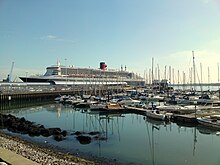
The city is deeply connected to the Cunard Line and their fleet of ships, which are the only passenger vessels to be registered here (having "Southampton" on the stern). The people of Southampton showed their strong connection with Cunard on 11 November 2008 when the Cunard Liner RMS Queen Elizabeth 2 departed the city for the final time amid a spectacular fireworks display after a full day of celebrations.[95]
Proudly continuing the tradition of luxury cruising that began in 1840, Queen Victoria was successfully launched in December 2007 and was named by HRH The Duchess of Cornwall in a spectacular ceremony in Southampton.
In the spring of 2009, a fourth Cruise Terminal was opened in Southampton and Carnival Corporation & plc moved the headquarters of Carnival UK to Southampton.[96][97]
Many of the world's largest cruise ships (including record-breaking vessels operated by P & O - Cunard's sister company based in the UK - and Royal Caribbean and Cunard) ships as well can regularly be seen in Southampton Water
[edit] Media
Local media include the Southern Daily Echo newspaper based in Redbridge and BBC South, which has its regional headquarters in the city centre opposite the civic centre. From there the BBC broadcasts South Today, the local television news bulletin and BBC Radio Solent. The local ITV franchise is Meridian, which has its headquarters in Whiteley, around nine miles (14 km) from the city. Until recently, the station's studios were located in the Northam area of the city on land reclaimed from the river itchen. Commercial radio stations broadcasting to the city include Hampshire's Play Radio—which until 2007 was run by Southampton F.C.[98] and known as The Saint, Wave 105 dealing with Adult contemporary music, Galaxy South Coast (previously known as Power FM) playing popular music, Heart Hampshire also dealing with Adult contemporary music and The Coast (radio station).
Southampton's University has a radio station called SURGE on AM band as well as through the web.
Between 1983–1992 the What's On listings magazine Due South was run from Southampton.
The city's information-packed Pocket Guide, which details all Southampton's accommodation venues, places to eat, drink, shop and be entertained is published by local company Walking Distance, champions of the city whose core business is promoting what's on in and around Southampton.
[edit] Sport
Southampton is home to Southampton Football Club—nicknamed "The Saints"—who play in the Football League One at St Mary's Stadium, having relocated in 2001 from their 103-year-old former stadium, "The Dell". They reached the top flight of English football (First Division) for the first time in 1966, staying there for eight years. They lifted the FA Cup with a shock victory over Manchester United in 1976, returned to the top flight two years later, and stayed there for 27 years (becoming founder members of the Premier League in 1992) before they were relegated in 2005. Their highest league position came in 1984 when they were runners-up in the old First Division. They were also runners-up in the 1979 Football League Cup final and 2003 FA Cup final. Notable former players include Alan Ball (who was later the club's manager), Theo Walcott, Wayne Bridge, Martin Chivers, Kevin Keegan, Matthew Le Tissier, Alf Ramsey, Alan Shearer, Peter Shilton, Bobby Stokes and Mark Wright. Notable former managers include Lawrie McMenemy, Chris Nicholl, Ian Branfoot, Graeme Souness, Dave Jones, Glenn Hoddle, Gordon Strachan, Paul Sturrock, Harry Redknapp and George Burley. In May 2009, The Saints were relegated to League One. They have a famous rivalry with Portsmouth F.C. ("South Coast derby") which is located only about 30 km away.
The two local Sunday Leagues in the Southampton area are the City of Southampton Sunday Football League and the Southampton and District Sunday Football League. Hampshire County Cricket Club play close to the city, at the Rose Bowl in West End, after previously playing at the County Cricket Ground, near the city centre.
The city hockey club, Southampton Hockey Club, founded in 1938, is now one of the largest and highly regarded clubs in Hampshire, fielding 9 senior men's and 5 senior ladies teams on a weekly basis along with boys’ and girls’ teams from 6 upwards.
The city is also well provided for in amateur men's and women's rugby with a number of teams in and around the city, the oldest of which is Trojans RFC who were promoted to London South West 2 division in 2008/9. Tottonians are also in London South West division 2 and Southampton RFC are in Hampshire division 1 in 2009/10, alongside Millbrook RFC and Eastleigh RFC. Many of the sides run mini and midi teams from under sevens up to under sixteens for both boys and girls.
The city provides for yachting and water sports, with a number of marinas. From 1977 to 2001 the Whitbread Around the World Yacht Race, which is now known as the Volvo Ocean Race was based in Southampton's Ocean Village marina.
The city also has the Southampton Sports Centre which is the focal point for the public's sporting and outdoor activities and includes an Alpine Centre, theme park and athletics centre which is used by professional athletes. With the addition of 11 other additional leisure venures which are currently operate by the Council leisure executives. However these have been sold the operating rights to "Park Wood Leisure."[99]
Southampton was named "fittest city in the UK" in 2006 by Men's Fitness magazine. The results were based on the incidence of heart disease, the amount of junk food and alcohol consumed, and the level of gym membership.[100] In 2007, it had slipped one place behind London, but was still ranked first when it came to the parks and green spaces available for exercise and the amount of television watched by Sotonians was the lowest in the country.[101] Speedway racing took place at Bannister Court Stadium in the pre-war era. It returned in the 1940s after WW2 and the Saints operated until the stadium closed down at the end of 1963. A training track operated in the 1950s in the Hamble area. Southampton is also home to one of the most successful College American Football teams in the UK, the Southampton Stags, who play at the Wide Lane Sports Facility in Eastleigh.
The world's oldest surviving bowling green is the Southampton Old Bowling Green, which was first used in 1299.[102]
[edit] Crime
According to government figures Southampton has a higher crime rate than the national average.[103] In the violence against the person category, the national average is 16.7 per 1000 population while Southampton is 42.4 per 1000 population and in the theft from a vehicle category, the national average is 7.6 per 1000 compared to Southampton's 28.4 per 1000. Overall, for every 1,000 people in the city, 202 crimes are recorded.[103] In August 2008, a Home Office crime report showed that Southampton is the 3rd most dangerous city in the UK.[104] Hampshire Constabulary's figures for 2009/10 show fewer incidents of recorded crime in Southampton than the previous year.[105]
[edit] Education
The city has a strong higher education sector. The University of Southampton and Southampton Solent University together have a student population of almost 40,000.[106]
The University of Southampton, which was founded in 1862 and received its Royal Charter as a university in 1952, has over 22,000 students.[107] The university is ranked in the top 150 to 200 research universities in the world in the Academic Ranking of World Universities 2008. In 2007, the THES - QS World University Rankings positioned the University of Southampton in the top 80 universities in the world. The university considers itself one of the top 10 research universities in the UK.[107][108][109] The university has a global reputation for research into engineering sciences,[110] oceanography, chemistry, cancer sciences, sound and vibration research,[111] computer science and electronics, optoelectronics and textile conservation at the Textile Conservation Centre[112] (which is due to close in October 2009.) It is also home to the National Oceanography Centre, Southampton (NOCS), the focus of Natural Environment Research Council-funded marine research.
Southampton Solent University has 17,000[113] students and its strengths are in the training, design, consultancy, research and other services undertaken for business and industry.[114] It is also host to the Warsash Maritime Academy, which provides training and certification for the international shipping and off-shore oil industries.
Southampton City College is the largest further education college operating in the city. The college offers a range of vocational courses for school leavers, as well as ESOL programmes and Access courses for adult learners.[115]
There are 79 schools in Southampton, comprising:
- 1 nursery school (The Hardmoor Early Years Centre in Bassett Green)
- 21 infant schools
- 16 junior schools
- 24 primary schools (ages 4 – 11)
- 10 secondary schools
- 2 academies (Oasis Academy Mayfield and Oasis Academy Lord's Hill)
- 5 special schools[116]
Over 40 per cent of school pupils in the city that responded to a survey claimed to have been the victim of bullying. More than 2,000 took part and said that verbal bullying was the most common form, although physical bullying was a close second for boys.[117]
It has been revealed that Southampton has the worst behaved secondary schools within the UK. With suspension rates three times the national average, the suspension rate is approximately 1 in every 14 children, the highest in the country for physical or verbal assaults against staff.[118]
[edit] Transport
For the history of transport in Southampton see:

Southampton is a major UK port which has good transport links with the rest of the country. The M27 motorway, linking places along the south coast of England, runs just to the north of the city. The M3 motorway links the city to London and also, via a link to the A34 road at Winchester, with the Midlands and North. The M271 motorway is a spur of the M27, linking it with the Western Docks and city centre.
Southampton is also served by the rail network, which is used both by freight services to and from the docks and passenger services as part of the national rail system. The main station in the city is Southampton Central. Rail routes run east towards Portsmouth, north to Winchester, the Midlands and London, and westwards to Bournemouth, Salisbury, Bristol and Cardiff.
Local train services operate in the central, southern and eastern sections of the city and are operated by South West Trains, with stations at Swaythling, St Denys, Millbrook, Redbridge, Bitterne, Sholing and Woolston. Plans were announced by Hampshire County Council in July 2009 for the introduction of tram-train running from Hythe (on what is now a freight-only line to Fawley) via Totton to Southampton Central Station and on to Fareham via St. Denys, and Swanwick.[119] The proposal follows a failed plan to bring light-rail to the Portsmouth and Gosport areas in 2005.
Southampton Coach Station, which is located near the West Quay Shopping Centre, was recently refurbished[when?].
Southampton Airport is a regional airport located in the town of Eastleigh, just north of the city. It offers flights to UK and near European destinations, and is connected to the city by a frequent rail service from Southampton Airport (Parkway) railway station, and by bus services.
While Southampton is no longer the base for any cross-channel ferries, it is the terminus for three internal ferry services, all of which operate from terminals at Town Quay. Two of these, a car ferry service and a fast catamaran passenger ferry service, provide links to East Cowes and Cowes respectively on the Isle of Wight and are operated by Red Funnel. The third ferry is the Hythe Ferry, providing a passenger service to Hythe on the other side of Southampton Water.

Buses now provide the majority of local public transport. The main bus operators are First Southampton and Bluestar. Other operators include Brijan Tours, Stagecoach, Velvet, Dorset Sprinter and Wilts & Dorset. The other large service provider is the Uni-link bus service (running from early in the morning to midnight), which was commissioned by the University of Southampton to provide transport from the university to the town. Previously run by Enterprise, it is now run by Bluestar. Free buses are provided by City-link and City Loop.[120] The City-link runs from the Red Funnel ferry terminal at Town Quay to Central station via WestQuay and is operated by Bluestar.[121] There is also a door to door minibus service called Southampton Dial a Ride, for residents who cannot access public transport. This is funded by the council and operated by SCA Support Services.
There are two main termini for bus services. As the biggest operator, First uses stops around Pound Tree Road. This leaves the other terminal of West Quay available for other operators. Uni-link passes West Quay in both directions, and Wilts & Dorset drop passengers off and pick them up there, terminating at a series of bus stands along the road. Certain Bluestar services also do this, while others stop at Bargate and some loop round West Quay, stopping at Hanover Buildings. There was a tram system from 1879 to 1949.
Southampton used to be home to a number of ferry services to the continent, with destinations such as San Sebastian, Lisbon, Tangier and Casablanca. A ferry port was built during the 1960s.[122] However a number of these relocated to Portsmouth and by 1996, there were no longer any car ferries operating from Southampton with the exception of services to the Isle of Wight. The land used for Southampton Ferry Port was sold off and a retail and housing development was built on the site. The Princess Alexandra Dock was converted into a marina. New car reception areas now fill the Eastern Docks where passengers, dry docks and trains used to be.
[edit] Areas and suburbs
| Clickable location map showing settlements and suburbs within Greater Southampton. O denotes settlements within Southampton city boundary; X represents settlements outside the boundary. |
- See also: Category:Districts of Southampton
Southampton is subdivided into council wards, suburbs, constituencies, ecclesiastical parishes, and other less formal areas.
Southampton is named the 'Green City' as it is graced with green spaces and parks. The largest green space is the 148 hectare Southampton Common,[123] parts of which are used to host the annual summer festivals, circuses and fun fairs. The Common includes Hawthorns Urban Wildlife Centre[124] on the former site of Southampton Zoo, a swimming pool and several lakes and ponds.
There are council estates such as those in the Weston, Thornhill and Townhill Park districts. Overall, the city is ranked 96th most deprived out of all 354 Local Authorities in England.[125]
During the 2006/07 financial year, 1,267 residential dwellings were built in the city—the highest number for 15 years. Over 94 per cent of these properties were flats.[126]
There are 16 Electoral Wards in Southampton, each consisting of longer-established neighbourhoods (see below).
There are also settlements outside the city boundaries that are sometimes considered suburbs of Southampton, including Chartwell Green, Chilworth, Nursling, Rownhams, Totton and West End.
|
|||||||||||||||||
[edit] Notable people
- See also: Category:People from Southampton
Notable people who either hail from Southampton or who have lived in the city include: Filmmakers Ken Russell and Chris Barfoot, who were both born in Southampton; Coldplay drummer, Will Champion, whose father[127] and late mother[128] taught at the university; R&B singer Craig David was brought up on the Holyrood estate in the city centre; SKY & International Radio Presenter Andy Collins and naturalist TV presenter Chris Packham are natives and Oscar-winning director of animated films Suzie Templeton grew up in Highfield. Southampton is also the origin of Drone Doom band Moss and alternative pop group Delays. Although many believe BBC Radio One DJ Scott Mills to come from the city he is actually from Eastleigh, he often states that his home was Southampton for convenience as many have not heard of Eastleigh, though comedian Benny Hill had a milk round there — the inspiration for his song Ernie (The Fastest Milkman In The West).
In the past, the city was home to Isaac Watts, a famous hymn writer, who notably composed O God, Our Help in Ages Past which is the school hymn of the King Edward VI school in the city and the peal of the Civic Centre clock tower.
Admiral John Jellicoe, commander of the British fleet at the Battle of Jutland was a Sotonian and Argentinian dictator Juan Manuel de Rosas spent his last years in exile in the city.
Author Jane Austen lived at her brother Frank's home in Southampton from the autumn of 1806 to the spring of 1809.
Merchant Mariner Charles Fryatt was born in Southampton in 1872.
Former England and Southampton footballer Matthew Le Tissier has lived in Southampton since the mid-1980s, and Olympic athlete Iwan Thomas lives here as did former tennis players Wally Masur and Eric Babin.

 Meher Baba's Life & Travels
Meher Baba's Life & Travels

















